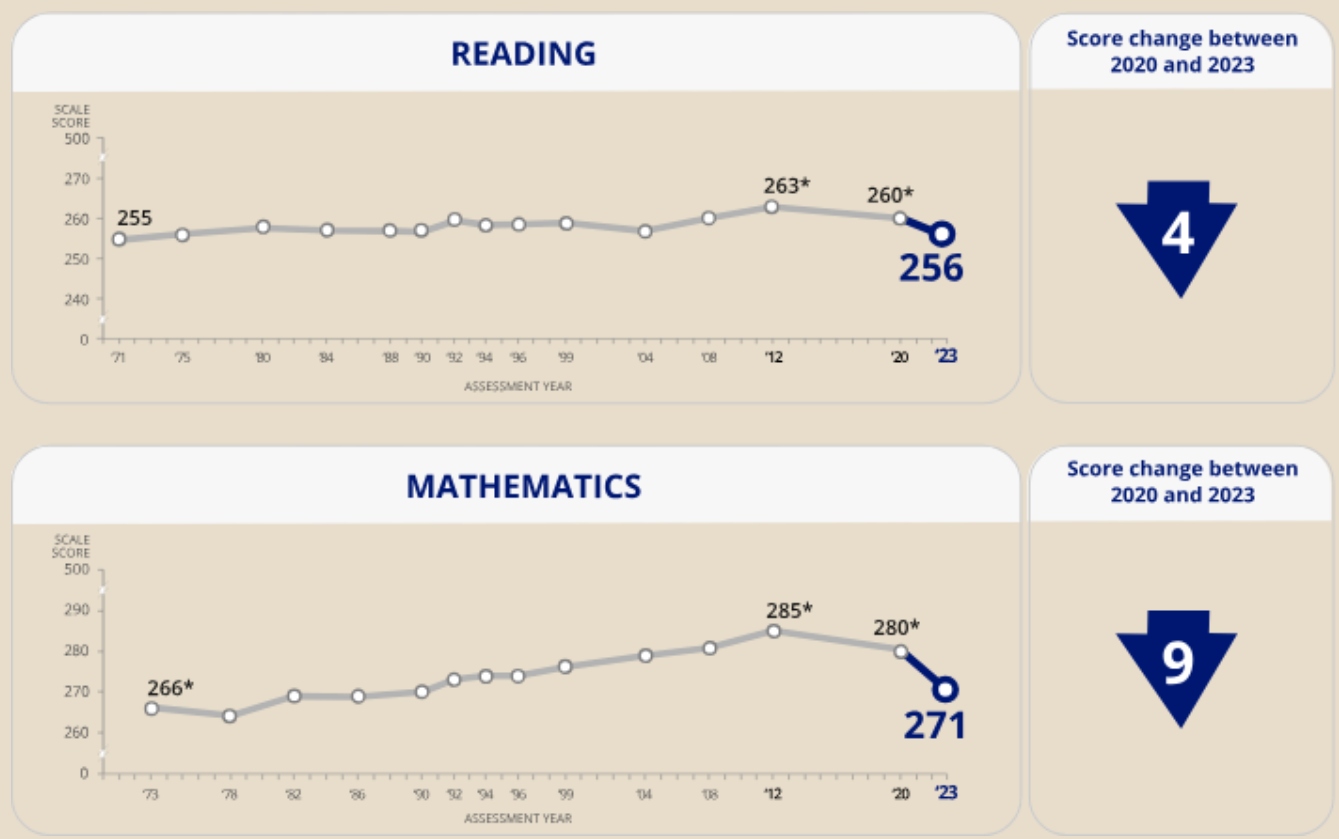Comments
- No comments found

The National Assessment of Educational Progress (NAEP) is sometimes called “the nation’s report card.” It tests a nationally representative group of students at ages 9, 13, and 17.
At an individual school, it’s possible for tests to get easier over time, or for grade inflation to result in higher letter grades for the same test scores. But the NAEP test is written so that the scores are directly comparable from year to year.
The test results offered some modest reasons for encouragement in the early 2000s. But the 2023 scores for 13 year-olds are bleak. The press release with the “highlights” is titled: “Scores decline again for 13-year-old students in reading and mathematics.” Here are the reading and math scores since 1971:

The test was previously given in 2020, so it’s plausible to read the scores as the result of many students losing at least a year of in-classroom education. A cynic would point out that scores were already falling from 2012 to 2020. The 2023 reading scores are essentially back to 1971 levels, and the math scores have fallen nearly that much. Scores fell for pretty much every group: by gender, race/ethnicity, public or private school, region of the country, and so on.
This is a survey, not an academic study, so it doesn’t seek to pin down causes and effects in a rigorous statistical way. But the survey data has some clues.
Absences are up. “[T]here were increases in the percentages of 13-year-old students who reported missing 3 or 4 days and students who reported missing 5 or more days in the last month. The percentage of students who reported missing 5 or more days doubled from 5 percent in 2020 to 10 percent in 2023.”
The share of students who read for fun is falling. “In 2023, fourteen percent of students reported reading for fun almost every day. This percentage was 3 percentage points lower than 2020, and 13 percentage points lower than 2012. Overall, the percentage of 13-year-old students who reported reading for fun almost every day was lower in 2023 than in all previous assessment years.”
Fewer students are taking algebra by age 13. “Compared to 2020, there were no significant changes in the percentages of students by type of mathematics taken during the 2022–23 school year. Compared to 2012, however, the percentage of 13-year-old students in 2023 who reported they were taking regular mathematics increased from 28 to 42 percent, while the percentage of students taking pre-algebra decreased from 29 to 22 percent, and the percentage of students taking algebra dropped from 34 to 24 percent.”
I’ve got no magic wand for improving school performance, but there are some tips from the research literature. For example international comparisons with countries that have high-performing K-12 education systems suggest the importance of 1) comprehensive and competitive exit exams for high school graduates; 2) competition between schools; and 3) teachers drawn from the top one-third of all college graduates. Lessons drawn from US charter schools that have success with low-income and minority students suggest the importance of five factors: 1) intensive teacher observation and training, 2) data-driven instruction, 3) increased instructional time, 4) intensive tutoring, and 5) a culture of high expectations. The resource inputs were more traditional things like per-pupil-spending and student-teacher ratios. In particular, the availability of small-group tutoring so that students don’t fall behind seems supported by a variety of studies.
Forty years ago in 1983, there was a National Commission on Excellence in Education which issued a report called “A Nation At Risk: Imperative For Educational Reform.” It caused a lot of hand-wringing at the time. Here are the often-quoted opening paragraphs from the 1983 report:
Our Nation is at risk. Our once unchallenged preeminence in commerce, industry, science, and technological innovation is being overtaken by competitors throughout the world. This report is concerned with only one of the many causes and dimensions of the problem, but it is the one that undergirds American prosperity, security, and civility. We report to the American people that while we can take justifiable pride in what our schools and colleges have historically accomplished and contributed to the United States and the well-being of its people, the educational foundations of our society are presently being eroded by a rising tide of mediocrity that threatens our very future as a Nation and a people. What was unimaginable a generation ago has begun to occur– others are matching and surpassing our educational attainments.”
If an unfriendly foreign power had attempted to impose on America the mediocre educational performance that exists today, we might well have viewed it as an act of war. As it stands, we have allowed this to happen to ourselves. We have even squandered the gains in student achievement made in the wake of the Sputnik challenge. Moreover, we have dismantled essential support systems which helped make those gains possible. We have, in effect, been committing an act of unthinking, unilateral educational disarmament.
As the 1983 report points out, the US has been losing its lead in education. Historically, the US was one of the first countries to have near-universal elementary education, and then one of the first countries to have a mass expansion of high school education, and then to have a mass expansion of college education. As other countries caught up in K-12 education, it used to be common, a few decades ago, to argue that the large share of US students going on to higher education helped to make up for the relatively poor performance of the US K-12 schools.
But now other countries have caught up, both in K-12 education and in the share of population going on to higher education. Other countries like Germany also have aggressive and wide-ranging apprenticeship programs for high school students to build skills and get connected to work opportunities.
The ongoing performance of the US K-12 system has been a slow motion crisis for decades. The drop-off of text scores among current 13 year-olds in the aftermath of the pandemic is another crisis. As far as I know, there isn’t any evidence that just giving existing teachers a raise, without more sweeping and fundamental changes, will make any difference. But we know that, on average, those who try to navigate 21st-century labor markets with education levels little different from the 1970s are facing a lifelong disadvantage.
Timothy Taylor is an American economist. He is managing editor of the Journal of Economic Perspectives, a quarterly academic journal produced at Macalester College and published by the American Economic Association. Taylor received his Bachelor of Arts degree from Haverford College and a master's degree in economics from Stanford University. At Stanford, he was winner of the award for excellent teaching in a large class (more than 30 students) given by the Associated Students of Stanford University. At Minnesota, he was named a Distinguished Lecturer by the Department of Economics and voted Teacher of the Year by the master's degree students at the Hubert H. Humphrey Institute of Public Affairs. Taylor has been a guest speaker for groups of teachers of high school economics, visiting diplomats from eastern Europe, talk-radio shows, and community groups. From 1989 to 1997, Professor Taylor wrote an economics opinion column for the San Jose Mercury-News. He has published multiple lectures on economics through The Teaching Company. With Rudolph Penner and Isabel Sawhill, he is co-author of Updating America's Social Contract (2000), whose first chapter provided an early radical centrist perspective, "An Agenda for the Radical Middle". Taylor is also the author of The Instant Economist: Everything You Need to Know About How the Economy Works, published by the Penguin Group in 2012. The fourth edition of Taylor's Principles of Economics textbook was published by Textbook Media in 2017.
Leave your comments
Post comment as a guest